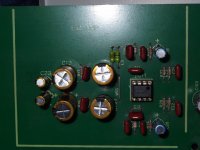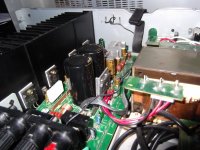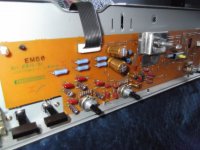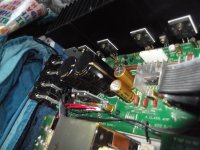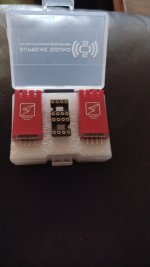I will be doing a full re-cap shortly. Using Slit foils on the PSU & Nichicon FGs elsewhere. I plan to upgrade the phono opamp at the same time.
My options could be opa2134 or opa2107. Does anyone have any thoughts which might be the best option?
My options could be opa2134 or opa2107. Does anyone have any thoughts which might be the best option?
Updates on the re-cap.
Replace all Electrolytic capacitors due to age. These are replaced with Kemet Slit foils for PSU smoothing.
Very tight fitment due to increased size.
Nichicon FG’s used elsewhere where available. Nichicon KA’s where FG’s not available. Nichicon VR’s on relay coils.
As part of the upgrade is to try out different opamps in the phono preamp section with the aim to achieve improved sound quality. Opamps available are JRC4580DD (original), OPA2134, LM4562, Burson V6 Vivid. A Gold DIP socket will be fitted to enable change of the opamps.
The Burson V6 Vivid was offered up by Burson as a free trial sample so as to provide an unbiased comparison of the opamps.
Awaiting sample.
The equipment used for the trial is as follows:
Custom turntable – Hardwood sandwich plinth, Inverted platter bearing with Magnetic levitation using samarium cobalt ring magnets, MDF platter with lead under-mat & cork mat, jelco tonearm, External platter belt drive using FG servo motor with strobe check, Shure M75ED cartridge & elliptical stylus set at 1.45G tracking force.
Kenwood KA-3020SE amplifier, Using Klotz interconnects. OFC 315 strand 2.5mm2 speaker cables.
Monitor Audio BX5 floor standing speakers.
A varying selection of Vinyl LP’s will be used to ascertain the differences in sound with each of the opamps.
Started intial burn in using the standard fitted JRC4580DD opamp.
initial results indicate vastly improved clarity & bass extension compared to standard unit, due to cap replacement.
After further hours of use I will do a full analysis & report.
Replace all Electrolytic capacitors due to age. These are replaced with Kemet Slit foils for PSU smoothing.
Very tight fitment due to increased size.
Nichicon FG’s used elsewhere where available. Nichicon KA’s where FG’s not available. Nichicon VR’s on relay coils.
As part of the upgrade is to try out different opamps in the phono preamp section with the aim to achieve improved sound quality. Opamps available are JRC4580DD (original), OPA2134, LM4562, Burson V6 Vivid. A Gold DIP socket will be fitted to enable change of the opamps.
The Burson V6 Vivid was offered up by Burson as a free trial sample so as to provide an unbiased comparison of the opamps.
Awaiting sample.
The equipment used for the trial is as follows:
Custom turntable – Hardwood sandwich plinth, Inverted platter bearing with Magnetic levitation using samarium cobalt ring magnets, MDF platter with lead under-mat & cork mat, jelco tonearm, External platter belt drive using FG servo motor with strobe check, Shure M75ED cartridge & elliptical stylus set at 1.45G tracking force.
Kenwood KA-3020SE amplifier, Using Klotz interconnects. OFC 315 strand 2.5mm2 speaker cables.
Monitor Audio BX5 floor standing speakers.
A varying selection of Vinyl LP’s will be used to ascertain the differences in sound with each of the opamps.
Started intial burn in using the standard fitted JRC4580DD opamp.
initial results indicate vastly improved clarity & bass extension compared to standard unit, due to cap replacement.
After further hours of use I will do a full analysis & report.
Attachments
Further update on the re-cap.
After some 50 hours of burn in I cant notice any discernable improvement in sound quality.
So therefore I have attached a RIAA response curve for the JRC4580DD.
This was done using Audacity to generate a chirp sweep from 20Hz to 20KHz & add an inverse RIAA EQ on top.
This signal is input into the phono inputs on the amplifier & a peak hold sweep measured at the rec-out connections using a picoscope 2205.
When all opamps have been tested the response curves can be compared.
I will try for a further few hours to see if there is any improvement then change opamps & do the listening test again with sweep test at the end.
After some 50 hours of burn in I cant notice any discernable improvement in sound quality.
So therefore I have attached a RIAA response curve for the JRC4580DD.
This was done using Audacity to generate a chirp sweep from 20Hz to 20KHz & add an inverse RIAA EQ on top.
This signal is input into the phono inputs on the amplifier & a peak hold sweep measured at the rec-out connections using a picoscope 2205.
When all opamps have been tested the response curves can be compared.
I will try for a further few hours to see if there is any improvement then change opamps & do the listening test again with sweep test at the end.
Attachments
It's the preamplifier section(that sucks) that needs to be eliminated. Theoretically you should try the phono stage(that sucks) without the succeeding stage. But unluckily the quality of the phono&preamp don't permit fine subtleties to be heard through the amp, which I owned for ten years working flawlessly. The only thing that I did was to put two new RCAs, two 2.2 uF film caps, and cables to new binding posts. And, oh yes, another preamp unit!
I must disagree with your conclusion that the pre-amp section is an issue. It is down to the quality of design & implementaion that decides how good the section operates.
The design is as it should be, I have checked the calculations for the circuit & they are correct for exact RIAA reproduction.
The layout of the board is as good as it can be with all signal tracks as short as possible & surrounded by ground planes at all points to minimise noise.
The use of opamps can be just as good as discrete components. Many high end phono preamps use opamps, such as Rega & Graham Slee.
The only issue is when the Kenwwod was built the quality of opamps were not available. Todays opamps have vastly improved & if used correctly can yeald extremely good results.
I am working through some of the opamps I have & have seen some vast improvements already.
Once I complete some of the analysis I will post the info.
The design is as it should be, I have checked the calculations for the circuit & they are correct for exact RIAA reproduction.
The layout of the board is as good as it can be with all signal tracks as short as possible & surrounded by ground planes at all points to minimise noise.
The use of opamps can be just as good as discrete components. Many high end phono preamps use opamps, such as Rega & Graham Slee.
The only issue is when the Kenwwod was built the quality of opamps were not available. Todays opamps have vastly improved & if used correctly can yeald extremely good results.
I am working through some of the opamps I have & have seen some vast improvements already.
Once I complete some of the analysis I will post the info.
First is a big thanks to John at Burson Audio for the trial V6 units supplied. Arrived today.🙂
I have to say that I have no affiliation with Burson Audio or any other commercial company.
Part 2 of testing involved replacing the JRC4580 with the Burr Brown OPA2134PA
I started testing using a premium 180G copy of Pink Floyds – The Wall.
The first obvious impression is that there is some improved detail, especially on quieter tracks which is probably due to the lower noise floor.
There appears to be better attack especially noticeable from the drums. There also some improvement in soundstage resulting in greater depth & openness.
The bass appeared tighter & to have lost some of the softness.
I feel that the very warm feeling of the Kenwood has somewhat been tamed resulting in a flatter response with less HF roll off & a more balanced sound.
This ties in with the flatter frequency response compared to the 4580 which had a raised section in the upper midrange. (See frequency plot below)
IMO this op-amp is an improvement over the 4580 since it provided a much more involving feel to the music. With a high quality 180G pressing this became much more apparent.
The only slight issue is that the op-amp felt slightly warm to the touch after running for a couple of hours whereas the 4580 was completely cool.
I intend to add more decoupling to the power rails at the IC pins to see if this gives any improvement.
This will be done at the time I do the next IC swap. I will then re-test to check temperatures.
I have to say that I have no affiliation with Burson Audio or any other commercial company.
Part 2 of testing involved replacing the JRC4580 with the Burr Brown OPA2134PA
I started testing using a premium 180G copy of Pink Floyds – The Wall.
The first obvious impression is that there is some improved detail, especially on quieter tracks which is probably due to the lower noise floor.
There appears to be better attack especially noticeable from the drums. There also some improvement in soundstage resulting in greater depth & openness.
The bass appeared tighter & to have lost some of the softness.
I feel that the very warm feeling of the Kenwood has somewhat been tamed resulting in a flatter response with less HF roll off & a more balanced sound.
This ties in with the flatter frequency response compared to the 4580 which had a raised section in the upper midrange. (See frequency plot below)
IMO this op-amp is an improvement over the 4580 since it provided a much more involving feel to the music. With a high quality 180G pressing this became much more apparent.
The only slight issue is that the op-amp felt slightly warm to the touch after running for a couple of hours whereas the 4580 was completely cool.
I intend to add more decoupling to the power rails at the IC pins to see if this gives any improvement.
This will be done at the time I do the next IC swap. I will then re-test to check temperatures.
Attachments
I had one of these in the 90s as well as many others such as rotel, marantz, Denon & mission & I preferred the sound of this one, It was highly regarded at the time. I managed to get one at a reasonable price to use on my vinyl collection. So decided to bring it up to date. So far not been disappointed.
Minor update.
Servisol super 10 arrived today so I've dismantled case again & cleaned all selectors & potentiometers as I was suffering from some crackling.
At the same time I've fitted 2 X 0.1uf x7r ceramic capacitors on the power pins of the eq chip on the underside of the PCB.
This should alleviate any issues with oscillation.
Servisol super 10 arrived today so I've dismantled case again & cleaned all selectors & potentiometers as I was suffering from some crackling.
At the same time I've fitted 2 X 0.1uf x7r ceramic capacitors on the power pins of the eq chip on the underside of the PCB.
This should alleviate any issues with oscillation.
Further to last post. Servisol cured the crackling issues. The extra decoupling caps seem to have cured the slight heating on the OPA2134.
I now have to add another device to the review list.
Thanks to Andrew at Sparkoslabs for agreeing to supply a SS3602 unit for review.
Just awaiting delivery.
My next move is to change to the LM4562 which I hope to do in the next couple of days.
Thanks to Andrew at Sparkoslabs for agreeing to supply a SS3602 unit for review.
Just awaiting delivery.
My next move is to change to the LM4562 which I hope to do in the next couple of days.
LM4562.
The first impression is the upper frequencies are more forward especially with the hi-hats & cymbals but never to the point of being harsh. The Bass is not as full as with the OPA2134 but there is more punch.
After quite a few hours of listening I would say overall the sound profile is neutral compared with the previous two opamps.
It would seem to be a rather clinical sound as though it has been recorded on a mirror. With the replay being exactly as it was recorded but somehow loses a sense of feeling & involvement.
The biggest issue is that any imperfections on the media seem to be amplified so much that any static is immediately audible.
Even my other half has commented how much crisper the sound is.
This one leaves me with a bit of a dilemma, is this the sound I should be looking for or do I prefer the more rounded involving sound? The jury is out.
I shall be fitting the Burson V6 vivid next to see what that brings to the party.
The first impression is the upper frequencies are more forward especially with the hi-hats & cymbals but never to the point of being harsh. The Bass is not as full as with the OPA2134 but there is more punch.
After quite a few hours of listening I would say overall the sound profile is neutral compared with the previous two opamps.
It would seem to be a rather clinical sound as though it has been recorded on a mirror. With the replay being exactly as it was recorded but somehow loses a sense of feeling & involvement.
The biggest issue is that any imperfections on the media seem to be amplified so much that any static is immediately audible.
Even my other half has commented how much crisper the sound is.
This one leaves me with a bit of a dilemma, is this the sound I should be looking for or do I prefer the more rounded involving sound? The jury is out.
I shall be fitting the Burson V6 vivid next to see what that brings to the party.
Attachments
When I checked, the discrete op amps lacked sufficient open loop gain for a phono stage
like yours, using global nfb. The bass response will be lacking in particular.
like yours, using global nfb. The bass response will be lacking in particular.
Hi Rayma,
Just fitted the Burson's.
I don't know where you have got that information from.
They are working absolutely fine, albeit running slightly warm, probably due to the +-17v power rails which is the maximum allowable.
I am going through a burn in period as that seems what most users do, before I do some listening tests.
Just fitted the Burson's.
I don't know where you have got that information from.
They are working absolutely fine, albeit running slightly warm, probably due to the +-17v power rails which is the maximum allowable.
I am going through a burn in period as that seems what most users do, before I do some listening tests.
The data sheet for V6 attached below, says the low frequency open loop gain is 70dB.
This is clearly insufficient for accurate equalization with a global negative feedback based
phono stage having the typical 60dB low frequency gain (which corresponds to 40dB mid band gain).
Such a small amount of excess gain (10dB) means inaccurate LF equalization and a rather
high sensitivity to the exact value of the open loop gain of the discrete op amp.
Your phono stage has a calculated 58dB low frequency gain (38dB midband), so the same comments apply.
Many suitable op amps have a well over 100dB low frequency gain asymptote (often 120dB or more).
This is clearly insufficient for accurate equalization with a global negative feedback based
phono stage having the typical 60dB low frequency gain (which corresponds to 40dB mid band gain).
Such a small amount of excess gain (10dB) means inaccurate LF equalization and a rather
high sensitivity to the exact value of the open loop gain of the discrete op amp.
Your phono stage has a calculated 58dB low frequency gain (38dB midband), so the same comments apply.
Many suitable op amps have a well over 100dB low frequency gain asymptote (often 120dB or more).
Attachments
Last edited:
I already have the data sheet & completely understand what you are saying.
However the actual results don't seem to tie in to your calculation.
Initial listening reveals a very balanced sound not lacking in low frequencies.
I have not checked the RIAA response yet.
If I get chance tomorrow I will do a quick check.
However the actual results don't seem to tie in to your calculation.
Initial listening reveals a very balanced sound not lacking in low frequencies.
I have not checked the RIAA response yet.
If I get chance tomorrow I will do a quick check.
Done a few checks.
At 0.75mV / 20Hz input the output is 360mV which is a gain of 54 db.
At 5mV (rms)/ 1KHz input the output is 360mV which is about a gain of 37db.
At 45mV / 20KHz input the output is 360mV which is a gain of 18db.
Below is a frequency sweep of the RIAA response, seems OK to me.
At 0.75mV / 20Hz input the output is 360mV which is a gain of 54 db.
At 5mV (rms)/ 1KHz input the output is 360mV which is about a gain of 37db.
At 45mV / 20KHz input the output is 360mV which is a gain of 18db.
Below is a frequency sweep of the RIAA response, seems OK to me.
Attachments
It seems that most of us have no idea how irrelevant are any mods and their subectively perceived conclusions for the rest of the world without the results of an audiometric test...
The first thing that should make anyone make a turn before even trying to share his thoughts about this topic is the countless hours of "burn in" that most modders claim to need before the sound "settles down"...
There's no burn in with new silicon equipment that would need more than half an hour to one hour to reach thermal equilibrium and that is only for class A high power amplifiers and high precision weighing scales or other high precision measurement instruments that are sensitive to ambient temperature...
Everything about burn in is only psycho acoustics.
You need to change the whole op-amp chain and coupling capacitors to be able to hear the first op amp qualities if any and you should be able to perceive any difference in the first 10 seconds of your listening session.Anything longer than that is your brain getting used with the sound.If it wouldn't be so, humanoids would have dissapeared a long time ago eaten by lions, cheetahs and crocodiles.Discovery channel will explain that to you better than i can.
Opa 2132 would have been a more natural choice for the first stage while OPA 2228 is a well known choice among tape machine preamp modders, but vinyl isn't tape... Next stages would enjoy unity gain stable op amps with low input bias .
Yet this "ordinary " chips being really expensive for most of us would it be of any interest for you to know that RME professional souncards use opa1692 moderately priced at 2 euros each or mid level best sales for three years Audient dirt cheap 0.5 euros NJM8080 for anything that's high input impedance circuit and there's a whole recording bussiness that back up their results?
Trying to paraphrase the New Old Stock of ne5532 quotes, there's a great chance that you're streaming right now some new indie records made on these op amps...
Besides Ka3020 phono preamp is really far from being a top end phono circuit that deserves 50 bucks op-amps.
The first thing that should make anyone make a turn before even trying to share his thoughts about this topic is the countless hours of "burn in" that most modders claim to need before the sound "settles down"...
There's no burn in with new silicon equipment that would need more than half an hour to one hour to reach thermal equilibrium and that is only for class A high power amplifiers and high precision weighing scales or other high precision measurement instruments that are sensitive to ambient temperature...
Everything about burn in is only psycho acoustics.
You need to change the whole op-amp chain and coupling capacitors to be able to hear the first op amp qualities if any and you should be able to perceive any difference in the first 10 seconds of your listening session.Anything longer than that is your brain getting used with the sound.If it wouldn't be so, humanoids would have dissapeared a long time ago eaten by lions, cheetahs and crocodiles.Discovery channel will explain that to you better than i can.
Opa 2132 would have been a more natural choice for the first stage while OPA 2228 is a well known choice among tape machine preamp modders, but vinyl isn't tape... Next stages would enjoy unity gain stable op amps with low input bias .
Yet this "ordinary " chips being really expensive for most of us would it be of any interest for you to know that RME professional souncards use opa1692 moderately priced at 2 euros each or mid level best sales for three years Audient dirt cheap 0.5 euros NJM8080 for anything that's high input impedance circuit and there's a whole recording bussiness that back up their results?
Trying to paraphrase the New Old Stock of ne5532 quotes, there's a great chance that you're streaming right now some new indie records made on these op amps...
Besides Ka3020 phono preamp is really far from being a top end phono circuit that deserves 50 bucks op-amps.
I can agree with some of your comments.
However the subjective listening tests only apply to the listener.
There are too many variables to take into account.
Such as the reviewers hearing quality, room acoustics, the interaction of each piece of equipment, etc.
So what may sound good to one person may be terrible for another.
I didn't say I believed the burn in routine just that some people do & there's no harm in doing so.
I had changed all the capacitors in the amp prior to any opamp changes.
My view is only what I persieve the differences are & may not be applicable to anyone else.
I know some high end equipment use some of the standard opamps & I have no issue with that, as the quality of the equipment is down to good design & application of the components used.
I have used & listened to loads of equipment in the 40+ years I've been using HI-FI gear & from my perspective the late 80s & early 90s equipment cannot be beaten in terms of quality of construction & design.
Your comments regarding the amp I'm using & it's phono circuit not being top end may be a bit misplaced.
A phono eq circuit can only be designed in a limited number of ways & is documented everywhere on how to achieve accurate RIAA response.
I looked at the design of many high end units which use opamps & discrete components & the layout in the Kenwood is no better or worse than those. Albeit the really top end units tend to use discretes.
So all I was trying to do is replicate a bit of those units discrete ideas at a much lower cost.
The High end units rely on supplying the amplifier with a quality front end, starting with the source.
So the old Adige applies, rubbish in equals rubbish out, so no matter how good the the amplifier or speakers are the sound will be poor if your feeding in rubbish.
So I've started with the turntable which is custom built, using maglift bearings, MDF platter with lead & cork mats, copper screening under platter, external platter belt drive from a FG servo motor, jelco tonearm, composite plinth from Hardwood/ cork sandwich resting on squash ball feet.
This thread is about improving the next piece in the chain. Which is down to imparting the least amount of noise, distortion & colouration in the signals journey.
Trying to do so in the most cost effective manner for the general public who cannot or don't want to spend many thousands of pounds on equipment for little or no benefit.
So at the end of the day, my opinion is only mine, and yours is only yours, & we are all entitled to pass them on hoping someone may benefit from the journey.
However the subjective listening tests only apply to the listener.
There are too many variables to take into account.
Such as the reviewers hearing quality, room acoustics, the interaction of each piece of equipment, etc.
So what may sound good to one person may be terrible for another.
I didn't say I believed the burn in routine just that some people do & there's no harm in doing so.
I had changed all the capacitors in the amp prior to any opamp changes.
My view is only what I persieve the differences are & may not be applicable to anyone else.
I know some high end equipment use some of the standard opamps & I have no issue with that, as the quality of the equipment is down to good design & application of the components used.
I have used & listened to loads of equipment in the 40+ years I've been using HI-FI gear & from my perspective the late 80s & early 90s equipment cannot be beaten in terms of quality of construction & design.
Your comments regarding the amp I'm using & it's phono circuit not being top end may be a bit misplaced.
A phono eq circuit can only be designed in a limited number of ways & is documented everywhere on how to achieve accurate RIAA response.
I looked at the design of many high end units which use opamps & discrete components & the layout in the Kenwood is no better or worse than those. Albeit the really top end units tend to use discretes.
So all I was trying to do is replicate a bit of those units discrete ideas at a much lower cost.
The High end units rely on supplying the amplifier with a quality front end, starting with the source.
So the old Adige applies, rubbish in equals rubbish out, so no matter how good the the amplifier or speakers are the sound will be poor if your feeding in rubbish.
So I've started with the turntable which is custom built, using maglift bearings, MDF platter with lead & cork mats, copper screening under platter, external platter belt drive from a FG servo motor, jelco tonearm, composite plinth from Hardwood/ cork sandwich resting on squash ball feet.
This thread is about improving the next piece in the chain. Which is down to imparting the least amount of noise, distortion & colouration in the signals journey.
Trying to do so in the most cost effective manner for the general public who cannot or don't want to spend many thousands of pounds on equipment for little or no benefit.
So at the end of the day, my opinion is only mine, and yours is only yours, & we are all entitled to pass them on hoping someone may benefit from the journey.
I dared to express my opinions here because i had your amp already yet i'm not really envious for not trying to mod it myself because i also had the KA-1000 before that.Almost every big audio company employs true musicians with at least a university degree in musicology to listen and review their best designs, yet i doubt Kenwood asked Pavarotti to review ka-3020 🙂 The reason for employing an educated ear for that is because not everyone can make good use of the first 10 seconds of a test to avoid any accidental " burn in" .When you do the tests that is exactly what you need to do: run 10 seconds tests of 100 different songs.If you can get relevant results out of it than it is ok.Nobody risks their most expensive wines with a sommelier that needs to drink the entire bottle before making an opinion...
- Home
- Amplifiers
- Solid State
- Kenwood KA-3020SE re-cap & phono opamp upgrade
